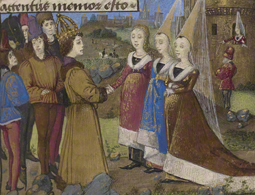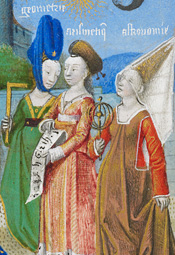|
Clothes are far more than a physical covering to protect the body from the elements; they can reveal much about a person. An evening gown, a doctor's white coat, cowboy boots—today these can all be clues to social status, profession, or geographic origin.
In the Middle Ages, clothing was integral to identifying one's place in the world. Medieval people were highly skilled at reading the meaning of fashion, which is reflected throughout the painted pages of illuminated manuscripts.
In Philosophy Presenting the Seven Liberal Arts to Boethius, female personifications of philosophy and the seven liberal arts are portrayed in a range of late medieval fashions.
Themes in this exhibition range from the extravagant cost of clothing worn by the elite, to styles and fabrics permitted by custom and law, to the inventiveness that embellishes historical depictions of fashion.
|
 |
|
While at times containing fanciful or idealized images of clothing, manuscript illuminations often reflect the actual styles and fabrics of the Middle Ages, as well as the economic factors behind them.
For the medieval viewer, color and material provided essential information about the social status of the figures on the page. For example, scholars wore red robes that carried the additional prestige associated with the high cost of crimson dye.
Peasants wore cheap, undyed wool in shades of brown and gray. Such distinctions offer valuable insights into the world of fashion, allowing us to imagine what the books' makers and owners might have been wearing and why.
In an image in which he is shown kneeling in prayer, Charles the Bold, Duke of Burgundy, wears a fabric of gold thread that, in the 1400s, was usually made by wrapping gilt-silver foil around a core of silk. Gold cloth was the ultimate status symbol in medieval clothing.
|
 |
 |

 |
 |
The Emperor Sigismund Arriving in Siena (detail), in The Story of Two Lovers, French, about 1460–70
|
 |
 |
|
Manuscript illuminators used costume to help place figures in the strict social hierarchy of the Middle Ages and to identify people by profession. Monks, doctors, lawyers, knights, scholars, queens, and courtiers could all be recognized at a glance by their distinctive clothing.
It would be a mistake to regard all illuminations as direct reflections of medieval dress. In chivalric romances, wealthy patrons sought images of a perfect world, populated with glamorous versions of themselves and even peasants that were too well dressed.
In an image made by an unknown French illuminator, fashions worn by the courtiers who accompanied the Emperor Sigismund reflect the way that impractical dress conveyed status. According to a law of 1463, short gowns that revealed men's buttocks were restricted to the upper classes.
|
 |
|
Since medieval manuscripts were often biblical or historical in nature, certain conventions arose for dressing figures from the past. Costumes for Christ and the apostles were based on the late classical garments seen in surviving Roman paintings.
Other biblical figures were clothed in whimsical interpretations of the fashions worn in the Middle East and beyond. Jews and Muslims were frequently presented in turbans, fanciful headdresses, and striped fabrics that were associated with contemporary non–Christians as well as people from ancient history.
A page from an Armenian Bible shows the Old Testament King David in the bejeweled ceremonial dress of Christian Byzantine emperors who had ruled the eastern portion of the Roman Empire. Although the Byzantine Empire had long ago fallen to the Ottoman Turks, its artistic traditions survived in Persia. King David's clothing nostalgically links him to the world of Byzantium and the ancient past.
|
 |



